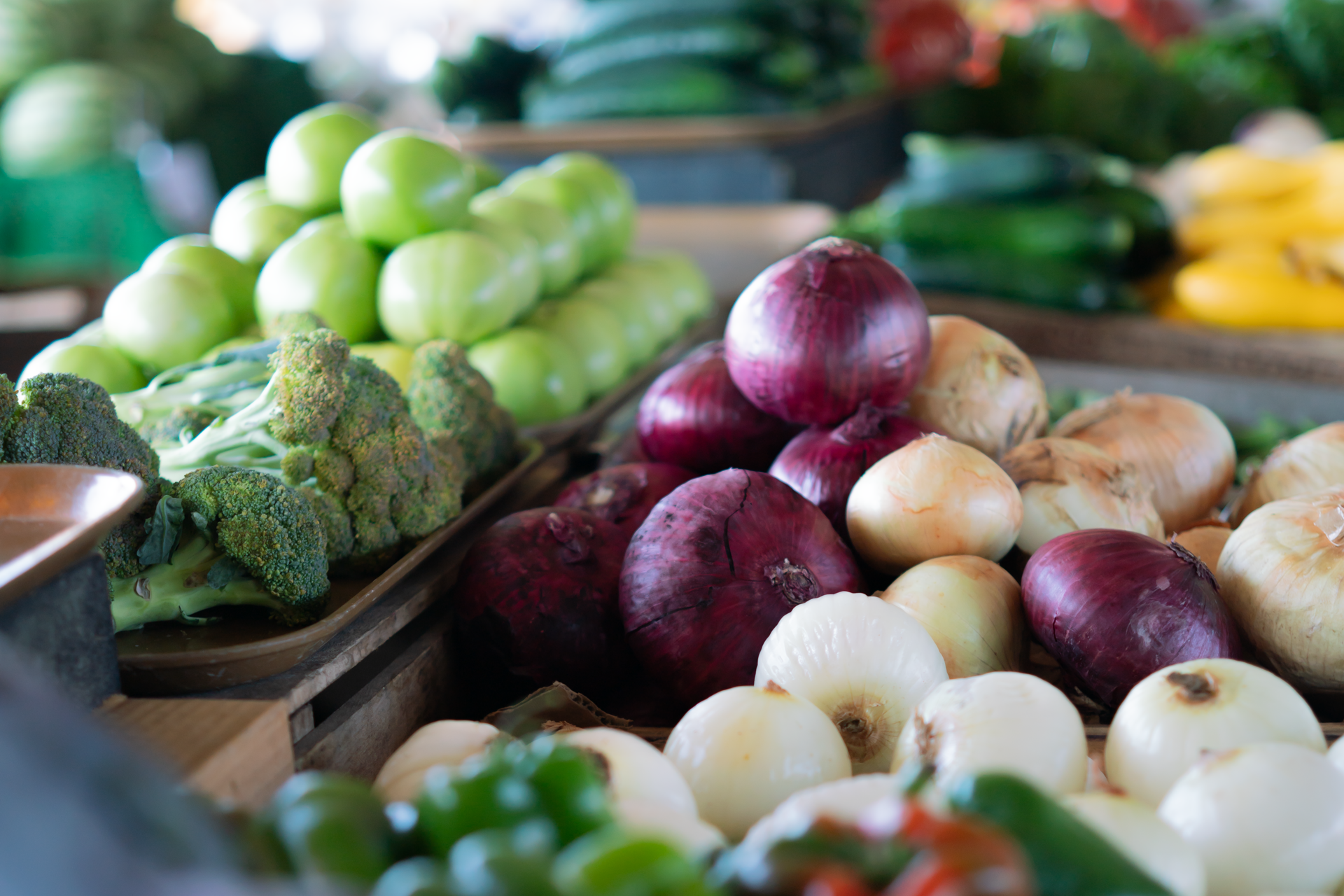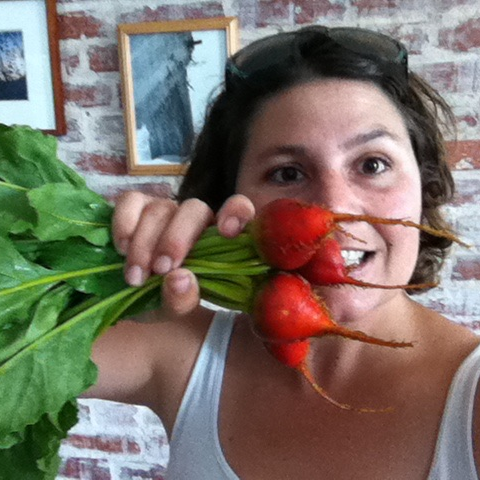
Follow Up: August Florida Food Forum
Farmer's Markets: Sourcing and Supporting the Local
If you were unable to attend the meeting, the full presentation is available to watch online here.
To keep the conversation going, please visit our forum on Urban Planning and the Florida Food System here to add your thoughts and comments.
On August 28th, the Florida Food Forum on Farmer’s Markets: Sourcing and Supporting the Local was led by Mary Hathaway, Co Manager of the Fresh Access Bucks program (FAB).
“I’m really excited,” Mary began, “to get the chance to start this conversation on the importance of local, and how to encourage local growers to participate at farmers markets, and how farmers markets are vital for small and beginning farmers and healthy food access.”
With her extensive experience, Mary holds a unique perspective on farmers markers. Currently working for Feeding Florida, the State’s network of food banks working to solve hunger, Mary acts as Co Manager of the Fresh Access Bucks program or “FAB,” which works closely with farmers markets, mobile markets, community supported agriculture programs, as well as farm stands.
In 2013, Florida Organic Growers first started the FAB program and in 2018, Feeding Florida was awarded a 3-year large-scale USDA Food Insecurity Nutrition Incentive Grant to expand the program. The current program within Feeding Florida continues its mission to increase access to good food for all Floridians while supporting Florida’s farmers and local economies. It is one organization among many nationally that works on joining fresh local food direct from farmers to community members of all income levels. Specifically, FAB takes federal dollars and incentivizes local community members to invest in their own health by matching, dollar-for-dollar, any SNAP dollars spent to purchase Florida-grown fruits or vegetables.
“We look holistically at our food system, taking into consideration the livelihood of the growers and their communities, as well as folks that are trying to take a step out of poverty—or just a pandemic—and lean on the support of federal benefits to make sure their family has good, healthy food. So, this really helps create a positive feedback loop, invigorating local farms and local economies.”
Mary described how local farmers at local farmers markets promote individual and public health, serving as conduits for healthy food, offering opportunities for ecological education, physical exercise, social life, and how they provide learning opportunities for every sector of the community.
“Today I want to share my love of local food, of the local economy, and seasonal eating; and I hope you’ll join me to work towards inclusive spaces that fuel robust communities with their own regional flair.”
How can we advocate for farmers markets? Why should we be advocates?
“As a consumer, you go to the farmers market. It’s fresh; it’s beautiful; it’s unique! You’ve got culturally appropriate items, you’ve got varieties grown for different ethnic populations, you’ve got items in different forms,” Mary said. “Local food looks and often tastes better. The crops are picked at the peak of their freshness, transport is minimal, and farmstead products like cheeses and yogurts, jams and bread, are handcrafted for best flavor.”
From variety to taste, there are a number of benefits gained from shopping at farmers markets including nutrition. “Local food doesn’t just look better, it’s better for you. The shorter the time between the farm and your table, the less likely it is that nutrients will be lost from fresh food.”
By the time fresh vegetables reach the grocery store, many have lost up to 45% of their nutritional content. So, it’s easy to see how buying directly from farmers is great for health, especially when “80% of direct-to-consumer farmers only sell within 100 miles of their farm.”
In her presentation, Mary cited a number of positives to shopping local. For one, local food preserves genetic diversity. Additionally, farmers are able to grow appropriate crops that fit the soils in their communities which is important when it comes to resilience and climate. Yet, her most compelling argument may be the idea that, “When you buy directly from your famer, you are engaging in a time-honored connection between eater and grower. Knowing a farmer gives you insights into the season, the land, your food, and in many places, it gives you access to where your children or grandchildren can go to learn about nature, their environment, and agriculture.”
What happens when we support local farmers?
“To ensure that local and regional food systems remain healthy and vibrant, and farmers stay in business, we need farmland. When you support your local farmer, you preserve open space.”
Mary explained that when farmers get paid more for their products by marketing local, they are less likely to sell land for development. And when you buy locally grown food, you are doing something proactive to preserve that landscape, which is an essential ingredient in other parts of the economic activity like tourism or recreation. Additionally, when farmers can keep land, they can invest in sustainable practices and help maintain healthy ecosystems.
“The American Farmland Trust shows that about 11 million acres of the nation’s irreplaceable agricultural land was lost just between 2001 and 2016. Which is more than all the land currently in production for fruits, vegetables and nuts,” Mary said, “Most of these local food farms are in the path of development— that’s 55% of the egg and poultry farms, 68% of dairy, 77% of the vegetables we eat are right there on that edge. So, farmland protection is really important, and it is most effective on the state level.”
Local food benefits the environment in many ways such as keeping taxes down and providing ecosystem services. “Well managed farms conserve fertile soil, they protect water sources, and they sequester carbon from the atmosphere. By supporting local farmers today, you are helping to ensure that there will be farms in your community tomorrow.”
How does supporting local help local communities?
“Local food supports local families. When you buy directly from farmers it cuts out the middleman and allows them to get full retail price for their food. There is research that show that farmers who use direct to consumer channels incur less debt and stay in business longer than those who sell through wholesale,” Mary explains. “Farmers markets provide one of the only low barrier entry points for new farmers, allowing them to start small as they learn and test the market. Small and mid-size farmers who sell at farmers markets have about a 10% greater chance of staying in business than those selling through traditional channels.”
Another important issue she touched on is inclusion. Farmers markets often operate in locations that traditional grocery stores may not want to be in, providing an opportunity for producers to be there for communities in need.
“As food systems work is about bringing everyone to the table, making connections, and supporting one another,” Mary says, “I just want to make sure everyone takes a moment to think about who we are leaving out and how we can do better. Don’t forget the role that you play at the local level so that all people have access, feel welcome, and actively participate, because a farmers market is for everybody.”
In her presentation she also took time to talk about the importance of Market Managers—aka community superheroes—and how their role makes it possible for farmers markets to operate.
“Farmers markets are these wonderful dynamic places that help increase access to fresh local food, they support local communities, and behind this there is a parking liaison, a special reasoner, a greeter, a community champion, a farm monitor, a property manager, event planner, business incubator, and that’s just one person—our market manager. That work encompasses so much, and it is a tough job.”
What has COVID-19 taught us? What kinds of policies do we need going forward?
“Food is political, because policy could be a tool to encourage a better supply chain to make sure everyone has access to affordable and healthy food,” Mary said. “A clear lesson of COVID-19 is that farmers market organizations that had the capacity to build strong relationships, or already had them, with elected officials or other community leaders were better positioned to make their needs known and ensure that markets were listed among essential businesses which is crucial for them staying open and to keep people aware of how to access those markets.
One of the things that she would like to see is a Florida specific definition of a “Farmers Market.” With this definition, “it could lead to greater clarity for Florida consumers and this would support more of our growers. It could also help expand funding for the WIC and Senior Farmers Market Nutrition Program (FMNP)...This is something we’ve seen other states do, and have great success, especially with encouraging people to buy from their farmers.” In fact, 31 states already have a definition through a statute or code.
With COVID-19 markets faced new challenges which, and many even had to temporarily shut down. Going forward, Mary proposed a number of changes that could help markets overcome these obstacles such as providing consistent, long-term access to free wireless EBT equipment and service, as well as aligning policies with available tech capabilities and the ability to access technical support from a contracted State SNAP processor or direct-marketing liaison.
“Every state has done something, but every state needs to do more.” One way to exercise agency is through “little p” policies—municipal laws, ordinances or resolutions that can be tailored to fit local needs and priorities in ways that state and federal laws cannot.
Mary concluded her presentation after illustrating a number of effective local policies and their effects on local communities, and how citizens can advocate for policies they are passionate about. She also provided a number of resources which can be found below.
Resources:
Fresh Access Bucks
Florida Farmers Market Association
UF/IFAS
Healthy Food Policy Project
Farmers Market Coalition
American Farmland Trust
Marketlink.org
To contact Mary, send her an email at Mary@feedingflorida.org

Bio: Mary Hathaway has worked as a farmer and an advocate for an equitable food system for more than 10 years. She is currently the Co Manager of Fresh Access Bucks (FAB), the statewide nutrition incentive program active in 62 farmers markets and direct to consumer outlets across Florida. Prior to this work, Mary earned a Masters degree in Agroecology where she spent her time working with Norwegian heritage-breed dairy operations and Tanzanian spice farmers. She lives on her small farm on the east coast of Florida with a few goats, hens and a toddler.
Forum Host: Dell deChant is the Associate Chair of the Religious Studies Department at the University of South Florida and a member of the Board of Directors at the Florida Food Policy Council.
The Florida Food Forum is a free event. To support our work, please consider becoming a member or making a donation. For questions or more information, contact us at: info@flfpc.org
Disclaimer: The views of the presenters do not represent the views of the Florida Food Policy Council. We are a forum for the offering and sharing of information and encourage diversity and communication within the food system.